Introduction
The twenty-first-century society is placing a larger focus on innovation as the driving force for development. When some problems arise, finding solutions requires not only the desire, skills, dedication, and time; it also requires creativity. No matter how surprising it is, creativity is currently at the center of modern activities and professions in the modern workplace. In terms of coding, creativity is also required; however, problem-solving is not the main issue.
Rather, creativity is needed to come up with doing something that could not be done previously. Therefore, exploring the links between creativity and coding has been identified as imperative. In the present study, the positive effects of creativity and coding will be evaluated both from the ‘big picture’ perspective as well as the narrow look on specific arguments in support of the topic.
Background
Starting from the overview of creativity as a concept, it is defined as “the ability to produce original and usual ideas or to make something new and imaginative” (Cambridge Dictionary). However, this concept is far from being as simple as its dictionary definition. As mentioned by Resnick, the process of creativity is represented by a spiraling cycle of six stages (Figure 1) that begin and end with imagination (1).
This cycle is perfectly catered to the needs of modern learners’ needs and expectations in terms of developing creative thinking skills. The stages can be enhanced with the help of modern technologies that capitalize on the success of traditional materials while extending the knowledge and skills developed through creativity.
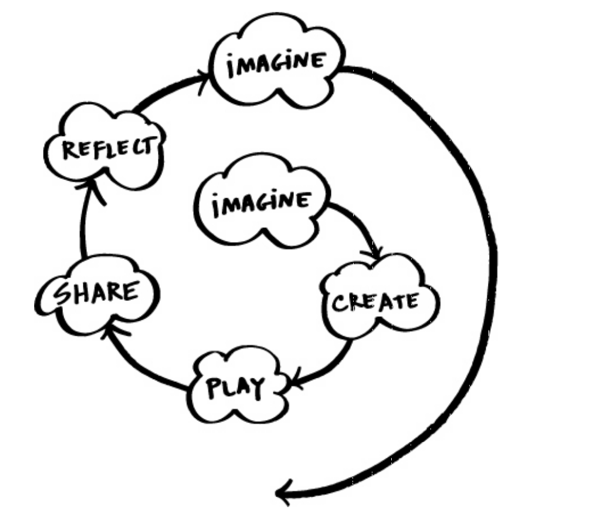
The spiral of creativity proposed by Resnick can be traced back to Hegel’s sublation spiral. The philosopher postulated that “that is what everything finite is: its sublation” (128). The concept of sublation is a translation from German aufheben. It is also referred to as abolishment, preservation, and transcendence, and is used for explaining the phenomenon that occurs when a thesis and antithesis interact. The spiral of creativity suggests that a creative idea starts with imagining something that can be created. This creation can then turn into a game that is played and shared. The entire experience results in a reflection that leads to new ideas and imagination.
Coding and Creativity
When it comes to coding, technologies used within the process enable creativity as it requires the reflection on past experiences and the redefinition of things that have been previously done differently. With the growing diversity of technologies and the expanding variety of consumer demands, coding must be creative. This can be illustrated with the help of examples from online tutorials such as the Hour of Code developed to teach users creative coding.
For the present exploration, a short tutorial for the Dance Party game available on the Hour of Code website was completed. The game was created by a dancer and software developer, Miral, (see figure 2) who supports the proposition that coding and creativity go hand-in-hand. Even the sole fact that the Dance Party was developed by someone who dances and creates software at the same time suggests the existence of multiple creative perspectives on coding. With the help of fellow creative people such as Aloe (figure 3), who is a singer and songwriter, the game has acquired a unique flare regarding the musical arrangement.
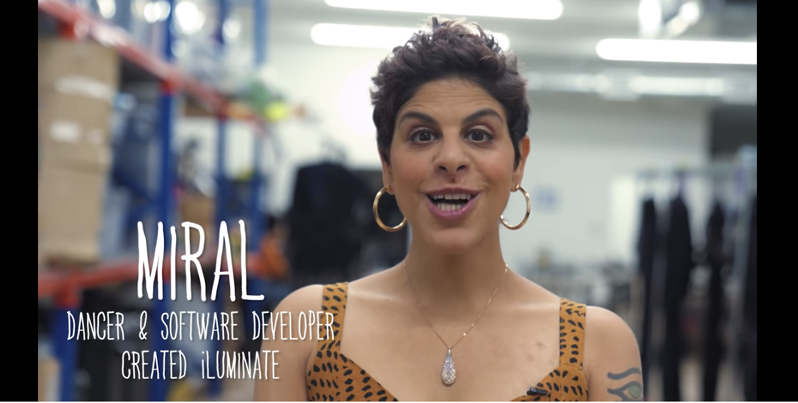
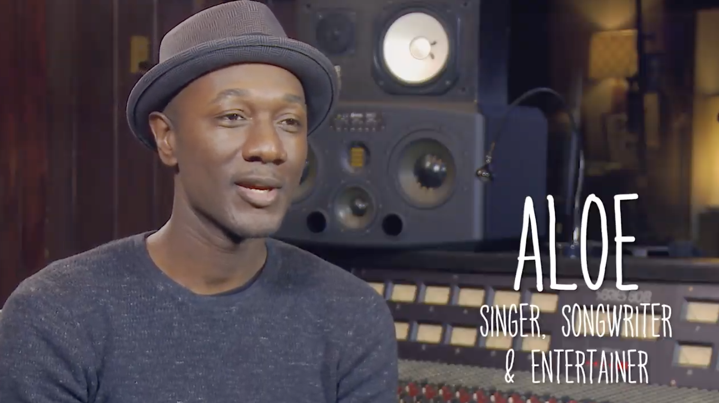
The Dance Party represents the epitome of coding and creativity working together to result in a fun and unique experience that will spark users’ imagination and satisfy the desire to play. During the tutorial, the users are instructed on how to create a virtual dance party using different fun characters and dance moves (see figure 4). The range of characters to select from depends on the creative desire of the developer, thus enabling the spirit of imagination.
The crazier the characters are and the more dance moves they do, the better. What is interesting about the tutorial for the dance game is that the target audience for the coding lesson is very vast: from second-graders to college graduates who are not that familiar with coding. Basic principles of coding are applied clearly, and the fun design of the characters enhances the experiences and makes it more interactive.
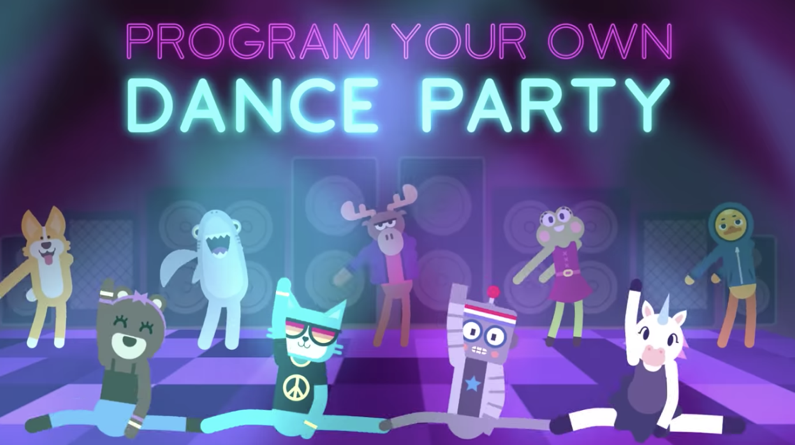
What is imperative to note is the attention to detail and the desire to engage users in creative coding by offering an extensive list of songs from which users can choose. From the old-school A-ha to Selena Gomez (figure 5), the list includes a range of songs that users of any age or musical preference can find appealing. This feature reflects the dance background of the developer who managed to combine creativity and coding in an engaging way for users.
However, the Dance Party is targeted at users who are familiar with the popular culture of the 21st century, and even the dance moves that characters do are rather modern. For example, ‘dabbing’ and ‘flossing’ are moves that have become popular only recently and will be understandable to those familiar with them. The game presents an opportunity for potential code learners to experiment and be entertained when completing basic tasks. The Dance Party follows the play space, toolbox, and workspace format (see figure 6). Such a simple breakdown between potential work areas is clear to users of any knowledge level while also playing the role of a creative outlet.
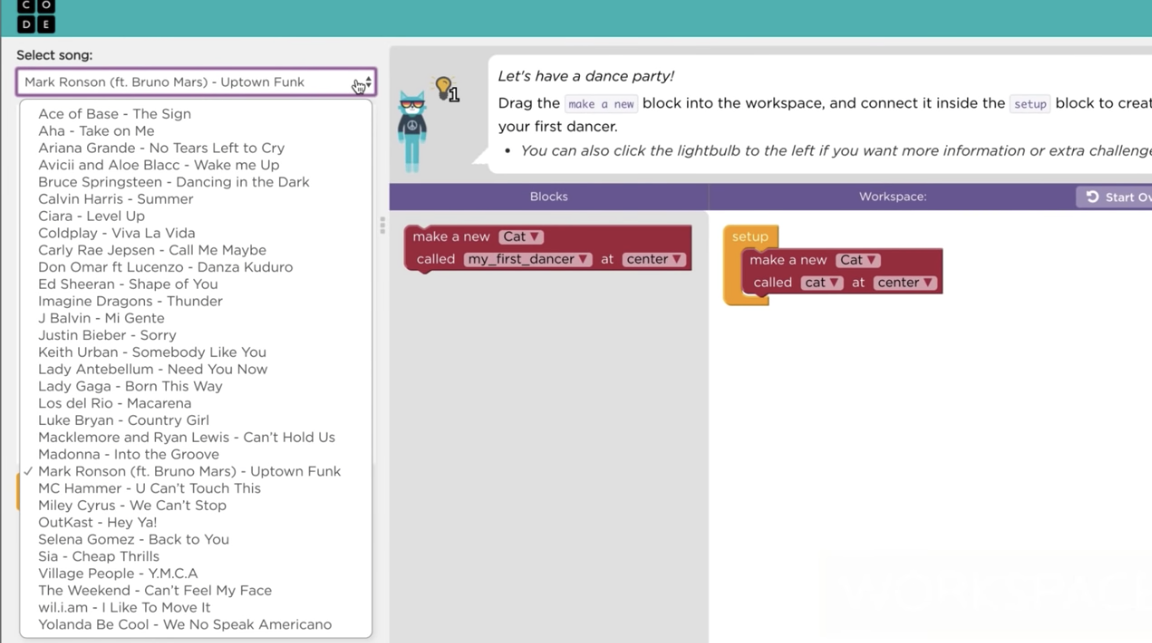
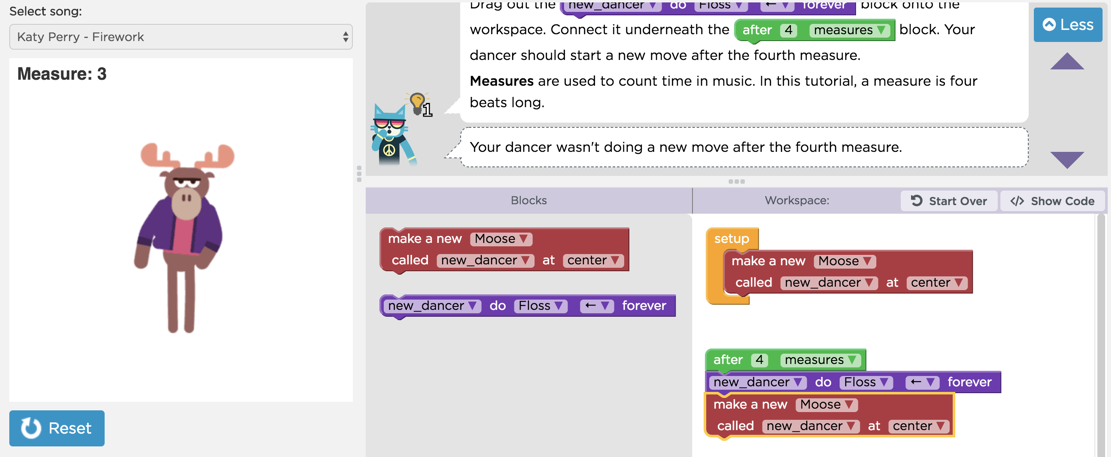
If to assess the combination of coding and creativity from business and political perspectives, the example of the Dance Party also applies. The developer of the game is an evident representation of the creative class, which is defined as a socio-economic group (coined by Richard Florida), which drives the economic development of US post-industrial cities. Miral belongs to the super-creative core of the creative class and uses her knowledge and talent to combine dance and coding. Thus, the seemingly incompatible relationship of creativity and coding works and it does so with tremendous benefits for society’s technological advancement and the expansion of skills.
In terms of the business perspective, software and games sell well. However, there is one important condition under which the latter can become successful – they have to be creative. Examining the most popular games of recent years, it becomes clear that the most elaborate, unexpected, colorful, and enticing games make the top of charts (“The Most Popular Video Games Right Now”). For instance, Fortnite, which is the most popular game at the moment that has amassed 125 million active players, is accessible, social, and spectacular. The creativity of its developers allowed them to include numerous enticing characteristics to make the game as attractive as possible, which lead to it becoming a cultural phenomenon (Conway). Without creative coding, Fortnite would have been more likely to fail.
The analysis has shown that coding is a complex creative process that requires users to think outside the box. Not much opposition to this finding has been presented since most people with the knowledge of technologies and computer science will agree that creativity is crucial. Criticism is directed not at creative coding per se but rather at software in general. It has been argued that the extensive knowledge of coding of people with inappropriate training can result in increased harm (Ko).
While this argument does not apply to creativity, it reflects the concern of some people as to the power technologies give to people, which is understandable and worth acknowledging. However, one important challenge to note as to creativity and coding is that the final product does not bear the meaning of creative work. Programmers are not seen as the producers of art but rather as professionals with the understanding of mathematics, symbols, and structures.
Conclusion
In summary, the combination of coding and creativity represents a unique opportunity for developing technology skills. Coding requires users to think critically and creatively while practicing their skills as often as possible. Programming is enticing because it can turn the ideas that were once imagined into reality. What is interesting is that both extremely artistic software developers and those who have no artistic inclinations can still be very creative when coding. Therefore, the same way in which painters share murals, those who code can create life-changing things and share them with the world.
Works Cited
Cambridge Dictionary. “Creativity.” Cambridge Dictionary. Web.
Conway, Steven. “The Clever UX that Made Fortnite a $1.2 billion Sensation.” Fast Company. 2018. Web.
Hegel, Georg Wilhelm Friedrich. The Encyclopaedia Logic, with the Zus Tze, Hackett Publishing Company, Inc., 1991.
Ko, Andy. “Why People Shouldn’t Learn to Code.” Medium. 2018. Web.
Resnick, Mitchel. “All I Really Need to Know (About Creative Thinking) I Learned (By Studying How Children Learn) in Kindergarten.” MIT Edu. Web.
“The Most Popular Video Games Right Now.” Ranker, 2018. Web.